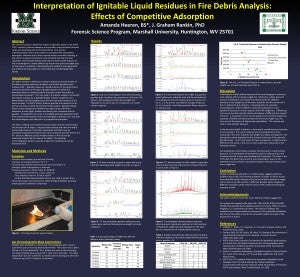Interpretation of Ignitable Liquid Residues in Fire Debris Analysis: Effects of Competitive Adsorption
Biography:
Mandy Heeren is from Ida Grove, Iowa. She attended South Dakota State University in Brookings, South Dakota, where she graduated with her BS in Chemistry with a minor in Biology. She is currently attending Marshall University working toward a Master of Science Degree in Forensic Science, emphasizing in Forensic Chemistry, Crime Scene Investigation, and Computer Forensics. This summer she did her research in the forensic chemistry lab at the Marshall University Forensic Science Program.
Abstract:
The common practice utilized for analysis of ignitable liquids is the ASTM E1412 method, passive headspace concentration using activated charcoal strips and classifying with the E1618 method. One area for misinterpretation stems from problems associated with competitive adsorption. Whether due to the increased surface area after charring, or the similar components located on the activated charcoal strip and substrates, initial studies demonstrate that the total overall response of the chromatogram is indeed affected by the amount (percent weight loss) of charring on a substrate. Understanding the problems associated with this method will aid analysts in interpreting and classifying ignitable liquids.
Poster:
References:
- Stauffer, E., Dolan, J.A., Newman, R., Fire Debris Analysis. Boston, MA: Academic Press, 2008.
- Petraco, NDK; Gil, M; Pizzola, PA; Kubic, TA, Statistical Discrimination of Liquid Gasoline Samples from Casework. J Forensic Science 2008;53(5):1092-1101
- ASTM E1618-06e1 Standard Test Method for Ignitable Liquid Residues in Extracts from Fire Debris Samples by Gas Chromatography-Mass Spectrometry, ASTM Annual Book of Standard, ASTM International, West Conshohocken, PA, 2009.
- Kelly, R, Competitive Adsorption of Ignitable Liquids on Charred Wood. Am. Acad. of For Science, 62nd Annual Mtg, Seattle WA, Feb. 2010; Abstract A91.
- ASTM 1412-07 Standard Practice for Separation of Ignitable Liquid Residues from Fire Debris Samples by Passive Headspace Concentration with Activate Charcoal, ASTM Annual Book of Standard, ASTM International, West Conshohocken, PA, 2009
